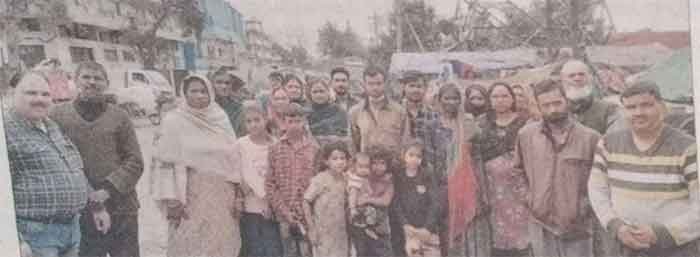
Increasing cold weather conditions have led to many vulnerable people remaining indoors as far as possible in Delhi. The pollution of the city mixed with fog and cold weather has also prompted those having vulnerable health conditions to avoid going out particularly in night and early morning.
It is really distressing and in fact shocking to know that the authorities have nevertheless continued to demolish hundreds of houses of poor and vulnerable people even during these times. The Indian Express reported on January 7 2024 that during this winter nearly 300 houses were demolished near DPS Mathura Road in Nizamuddin area (report by Saman Husain titled ‘Houses razed in demolition drives across capital, several left homeless in biting cold). A woman Lalita Devi has been quoted here as saying that she also lost her source of livelihood in the same demolition. While people here are quoted as saying that they have lived here for a very long time, the authorities said that they demolished the homes after consulting satellite imagery which did not show any settlement here in 2006. This is also a new situation when other evidence such as documents with people are not considered and instead satellite imagery is used. The demolition took place without rehabilitation effort so that the people here have become homeless in acute winter.
Five homes were demolished in Khirki Extension area near Malviya Nagar as well. A woman Chandrawati said they had no clue when the demolition would take place, and in fact she was cooking the family meal at the time. This is another case of demolition leading to more homeless people.
It is shocking and distressing that the impact on the health or even survival of people when suddenly thrown out in the biting cold weather mixed with high air pollution conditions was not even considered by the authorities while taking such actions.
If more people are being rendered homeless by such actions, then is the number of shelters for homeless people being increased at the same report?
No, says another report in The Times of India (Jan. 7, 2024) titled ‘Winter of discomfort: No shelter, fighting cold under the open sky’. This report by Ridhima Gupta tells us that one reason why there are so many homeless sleeping out in the biting cold of Delhi is that “in the past one year , several night shelters operated by the Delhi Urban Shelter Improvement Board (DUSIB) have been demolished and also because such shelters are not entirely safe for women and children.”
What is more, this report quotes activists working on this issue as saying that “DSUIB is fighting a case in court to demolish more shelters in Yamuna Pushta here.” As those familiar with the homelessness scene in Delhi know, the Yamuna Pushta has long been known for a high concentration of homeless people.
The existing shelters can’t be properly used by homeless people much in need of these who, particularly many women, prefer to sleep in the open even in the bitterly cold weather rather than go into the shelters. When the concerned reporter further visited the shelters, some of the complaints were confirmed further.
It appears that the survival conditions for the homeless people have been deteriorating even in the capital city where earlier quite a significant effort was made for improvement. One shudders to the think of the conditions in several other cities where this issue has received much less attention. As the Supreme Court had given significant directives for improvement, these should be monitored at the national level to find out to what extent these have been followed in the right spirit. Meanwhile, to prevent the further worsening of the distressing situation, any further demolitions during the winter should be stopped and clear instructions should be given that even later, demolitions should take place only when these are unavoidable any demolitions that cannot be avoided should be accompanied by a rehabilitation effort.
Bharat Dogra is Honorary Convener, Campaign to Save Earth Now. His recent books include Planet in Peril, Protecting Earth for Children and A Day in 2071. He was earlier associated with a leading program to help homeless people and contributed several booklets and articles on this subject.















































